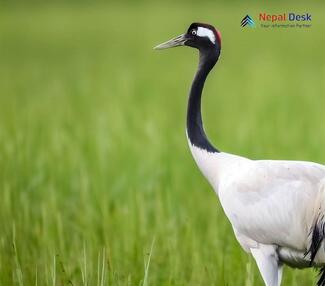A gorgeous bird species originating from the high-altitude wetlands of the Himalayas, the Black-necked Crane (Grus nigricollis) boasts a captivating appearance and notable size. Not only is it a feast for the eyes, but it also holds significant cultural value in Nepal and various areas across Asia. In this comprehensive profile, we'll delve into the fascinating features, habitat, and conservation initiatives related to Nepal's Black-necked Crane.
Looks and Traits
True to its name, the Black-necked Crane dons a remarkable black head and neck which distinguishes it from other crane varieties. Its body mainly flaunts grey feathers, complemented by red patches on its crown. The crane's long, slender legs come in handy when navigating through wetland ecosystems.
Adult Black-necked Cranes can reach up to five feet tall, with males being marginally larger than females. Despite their substantial size, they display exceptional elegance and nimbleness in flight as they travel vast distances during migration.
Where They Call Home
Black-necked Cranes are predominantly found in the Tibetan Plateau's high altitude wetlands and nearby regions. They significantly contribute to the ecological equilibrium of these areas. In Nepal, these awe-inspiring birds can be spotted in protected zones like the Koshi Tappu Wildlife Reserve and other locations along major river floodplains at elevations of 2,500 to 5,000 meters above sea level.
During the winter season, they journey to lower altitudes in search of food since their main habitat turns icy. They prefer open wetlands where they can feast on tubers, roots, insects, and small vertebrates. It is also common for these cranes to scavenge in nearby agricultural fields.
Challenges and Preservation Measures
The Black-necked Crane population is presently estimated to range between 10,000 and 12,000 members. Consequently, it's classified as a "Vulnerable" species on the IUCN Red List. Numerous factors contribute to the dwindling numbers, including loss of natural habitat from agricultural development, urbanization, and climate change. Furthermore, the cranes are endangered by hunting activities, unintended entrapment in fishing nets, and human interference around nesting locations.
To help protect these majestic creatures in Nepal, conservation measures focus on preserving and restoring their cherished wetland habitats. This involves implementing strict protection perimeters around essential nesting sites. In addition, local populations are being educated on the significance of maintaining a healthy wetland environment for the cranes to thrive. Global collaboration among countries along these birds' migratory paths is crucial for ensuring their long-term survival.
In summary, the Black-necked Crane symbolizes both Nepal's cultural heritage and ecological importance. By understanding these elegant birds and promoting conservation endeavors aimed at preserving their home, we can do our part in protecting these feathered marvels for future generations to appreciate.


